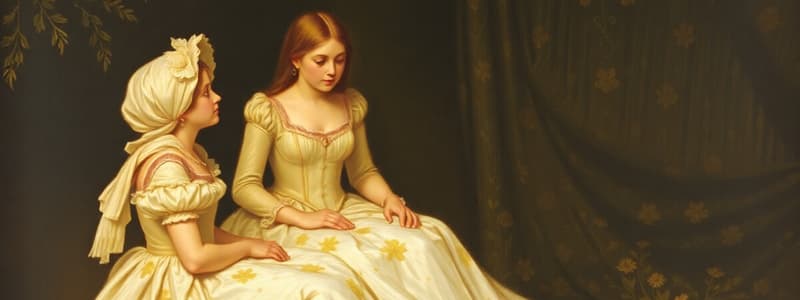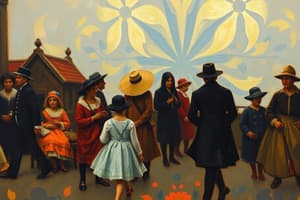Podcast
Questions and Answers
According to Baum's definition, what does culture emphasize?
According to Baum's definition, what does culture emphasize?
- Genetic predispositions
- Concrete practices and customs (correct)
- Internal mental states
- Abstract concepts and beliefs
According to Baum, altruism is a minor characteristic of a society.
According to Baum, altruism is a minor characteristic of a society.
False (B)
How do behaviorists define culture, as opposed to the pre-1970s anthropologists?
How do behaviorists define culture, as opposed to the pre-1970s anthropologists?
Behaviorists define culture concretely, referring to shared practices and observable behavior.
According to Baum, culture is acquired through learning as a result of ______.
According to Baum, culture is acquired through learning as a result of ______.
Match the following concepts with their descriptions related to cultural evolution:
Match the following concepts with their descriptions related to cultural evolution:
What is cultural transmission primarily based on?
What is cultural transmission primarily based on?
Guided variation is narrower than Skinner's design of culture because it only includes instances with verbal behavior.
Guided variation is narrower than Skinner's design of culture because it only includes instances with verbal behavior.
What is the primary focus of cultural replicators?
What is the primary focus of cultural replicators?
According to Baum, traits benefiting the group at a cost to the individual can be selected when groups compete and ______.
According to Baum, traits benefiting the group at a cost to the individual can be selected when groups compete and ______.
Match the following concepts with their roles in an experimental society:
Match the following concepts with their roles in an experimental society:
What is the significance of 'small costs, large benefits' in the context of cultural traits?
What is the significance of 'small costs, large benefits' in the context of cultural traits?
In societies of unrelated individuals, altruism can be selected through benefits to shared altruistic genes.
In societies of unrelated individuals, altruism can be selected through benefits to shared altruistic genes.
How does Baum use group selection to explain 'self-sacrificing' behavior?
How does Baum use group selection to explain 'self-sacrificing' behavior?
Cultural transmission is ______ than biological evolution because it occurs throughout an individual’s lifespan and can spread rapidly through a group.
Cultural transmission is ______ than biological evolution because it occurs throughout an individual’s lifespan and can spread rapidly through a group.
Match the term with its key characteristic:
Match the term with its key characteristic:
Besides culture, what else does Baum relate altruism to?
Besides culture, what else does Baum relate altruism to?
Cultural replicators are best defined as beliefs and ideas instead of activities and practices.
Cultural replicators are best defined as beliefs and ideas instead of activities and practices.
How does selective transmission occur?
How does selective transmission occur?
Guided variation is equated with behavior that is individually ______ and then transmitted by imitation or teaching.
Guided variation is equated with behavior that is individually ______ and then transmitted by imitation or teaching.
Match the type of happiness with its description:
Match the type of happiness with its description:
Flashcards
Learned Behavior
Learned Behavior
Culture is acquired through learning as a result of group membership.
Shared by a Group
Shared by a Group
Learned behaviors shared among a group's members.
Operant Behavior
Operant Behavior
Culture consists of operant behavior, both verbal and nonverbal.
Socially Reinforced
Socially Reinforced
Signup and view all the flashcards
Transmitted
Transmitted
Signup and view all the flashcards
Population-level phenomenon
Population-level phenomenon
Signup and view all the flashcards
Definition of Society
Definition of Society
Signup and view all the flashcards
Sacrifice and Cheating
Sacrifice and Cheating
Signup and view all the flashcards
Small Costs, Large Benefits
Small Costs, Large Benefits
Signup and view all the flashcards
Social Reinforcement
Social Reinforcement
Signup and view all the flashcards
Self-interest
Self-interest
Signup and view all the flashcards
Benefits of Group Living
Benefits of Group Living
Signup and view all the flashcards
Cultural Practices
Cultural Practices
Signup and view all the flashcards
Variation
Variation
Signup and view all the flashcards
Cultural Transmission
Cultural Transmission
Signup and view all the flashcards
Selection
Selection
Signup and view all the flashcards
Cultural replicators
Cultural replicators
Signup and view all the flashcards
Guided variation
Guided variation
Signup and view all the flashcards
Experimental society
Experimental society
Signup and view all the flashcards
Fitness
Fitness
Signup and view all the flashcards
Study Notes
Baum's Definition of Culture
- Culture involves customs shared by a group, emphasizing concrete practices.
- Culture is learned through group membership.
- Learned behaviors are shared among group members.
- Culture includes both verbal and nonverbal operant behavior.
- Behaviors are acquired through group-arranged consequences.
- Cultural practices are transmitted between group members.
- Culture is a population-level phenomenon.
Anthropologists vs. Behaviorists on Culture
- Before the 1970s, anthropologists defined culture using abstract concepts like shared attitudes and beliefs.
- Marvin Harris defined culture through shared customs/behaviors.
- Behaviorists define culture concretely by shared practices (verbal and nonverbal).
- Behaviorist approach focuses on observable behavior over internal mental states.
- Psychologists and evolutionary biologists influenced the redefinition of culture in behavioral terms.
Altruism and Society
- Society is defined as a stable group living together, acting altruistically.
- Altruism is a key characteristic of a society.
- A society is marked by stable group association with altruistic behavior.
- Altruism in closely related individuals may be selected through shared altruistic genes, reducing need for reciprocity.
- In unrelated individuals, mutual benefit depends on reciprocity.
- Remembering group members and tracking debts are selected alongside altruistic genes to ensure reciprocity.
- Societal members may sacrifice resources for the group, while cheating must be curbed to maintain cohesion.
Culture: Costs, Benefits, and Self-Interest
- Traits crucial for culture involve small individual costs for large group benefits.
- Social reinforcement allows members to shape each other's behavior, increasing group survival.
- Replicators (genes or practices) act out of self-interest.
- Some genetically coded traits and cultural practices promote group survival at the individual's expense.
- Genes may be selected to subordinate individual welfare to the group, explaining altruism/cooperation.
Group Selection and Self-Sacrifice
- Group selection explains self-sacrificing behavior.
- Traits benefiting the group but costing the individual can be selected when groups compete/succeed (or fail) as units.
- Individuals sacrifice resources, risk injury, or forgo reproduction for group membership benefits.
Benefits of Group Living
- Animals feeding together spend more time feeding and less time watching for predators.
- Genes can induce alarm calls when a predator is present, benefiting the group.
- Food sharing among kin is common, extending to non-kin based on group benefit compared to groups with less sharing.
- Genes promoting behavior patterns are selected by group selection when benefits to the individual as a group member outweigh costs.
Maintenance of Cultural Practices via Genetics
- Genes may be selected to subordinate individual welfare for the group.
- These genes need only do better on average and in the long run compared to genes prioritizing individual short-term benefit first.
- Cultural practices promote cohesion, cooperative breeding, hunting, food sharing, and defense.
- These practices contribute to group success, even if costly to individuals.
- Warfare can drive the evolution of cooperative activities and benefit the group in cohesion, defense, and resource acquisition.
- Tribes engage in warfare involving raids, murder, skirmishes, and battles, taking vital resources (territory, animals, people).
Genetic vs Cultural Evolution
- Genetic evolution requires different alleles at gene locations.
- Cultural evolution needs various cultural "alleles" to compete and make trait packages possible.
- Cultural replicators or practices vary in execution/expression within a group, defined by their function and activities.
- Novelty arises through mutation, recombination, and immigration.
- Accidents/errors in behavior lead to novel variants.
- Immigration introduces new practices.
- Cultural transmission involves transferring behavior from one group member to another, unlike genetic transmission from parent to offspring.
- Acquired characteristics can be inherited in cultural evolution through learning.
- Transmission occurs through imitation and rule-governed behavior.
- Cultural transmission is faster than biological evolution because it occurs during an individual's life.
- Selection in cultural evolution occurs through differential survival and reproduction of practices.
- Cultural replicators can be longer-lived, more fecund, or more faithfully copied.
- Practices directly affecting survival/reproduction are naturally selected.
- Selective transmission favors imitating success.
- Cultural group selection occurs when groups compete, favoring practices that promote group cohesion/cooperation.
- Replicators are selfish, selecting for traits subordinating individual's welfare to the group.
Cultural Replicators
- Cultural replicators are units of selection in cultural evolution, analogous to genes.
- A cultural replicator is an activity engaged in and transmitted by the group, serving a function, resulting in a certain effect, or accomplishing a certain result.
- Cultural replicators are activities or practices (verbal and nonverbal) rather than beliefs, ideas, or values.
- They are identified by their function or the result achieved.
- They vary in size from artifacts/actions to clusters of interdependent customs.
- Like genes, some variants among cultural replicators are longer-lived, more fecund, or faithfully copied.
Examples of Cultural Replicators
- Specific verbal practices, such as greetings or bargaining.
- Traditional utterances, such as sayings, stories, myths, moral injunctions, instructions, and knowledge.
Guided Variation
- Guided variation is behavior individually acquired then transmitted by imitation/teaching.
- Definition is broader than Skinner’s notion of design of culture because it includes instances involving no verbal behavior.
- Adaptation through rational calculation proceeds via collection of information, estimation of results, evaluation of desirability.
- Guiding criteria translate environmental variation into directional change in phenotype, culturally transmitted and naturally selected.
Skinner's Experimental Society
- Skinner proposed an experimental society that constantly tries new cultural practices to address challenges.
- Society should experiment with new practices as a cultural norm.
- Cultural practices change too slowly and practices that have worked in the past may become maladaptive and need to be replaced.
- Design of culture involves more experimentation, planning, and evaluation.
- Survival implies change in response to long-term relations.
- Solely responding to short-term relations usually spells disaster- Short-term and long-term relations usually can conflict.
- Experts should make guesses about long-term consequences to recommend new practices.
- Skinner equated guided variation with design of culture.
Improving Fitness
- Regulation reinforces behavior with desirable long-term consequences.
- Change depends on groups responding to expert predictions.
- Verbal behavior generates discriminative stimuli promoting new practices.
- Practices change to prevent significant decrease in and to increase fitness.
Objections of Experimental Society
- Control of actions is based on simplified conditions, far removed from the complexities of everyday life. Yet, science must start with simplification to learn how to deal with complexities.
- Design may lead to regimentation/uniformity, removing diversity. Yet, designs could support diversity.
Defining Happiness
- Freedom from aversive control: greater happiness when free from threats of aversive consequences or removal of accustomed reinforcement.
- Choice: environments providing choices with reinforcing consequences.
- Freedom from exploitation and equitable reinforcers: long-term happiness when free from exploitive relationships, receiving equitable reinforcers.
- Fitness: happiness coincides with fitness, deriving from personal survival/comfort, welfare of family, and beneficial relationships.
- Short-term happiness relates to immediate personal reinforcement.
- Long-term happiness relates to reproductive success/survival of culture.
- Long-term happiness often has a conflict with short-term personal reinforcement.
Studying That Suits You
Use AI to generate personalized quizzes and flashcards to suit your learning preferences.





